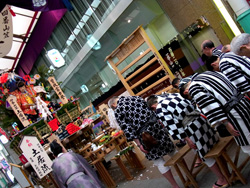
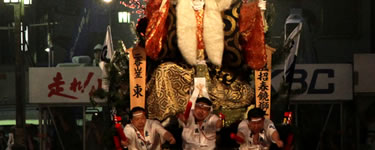
Hakata Yamakasa: Rites & Rituals
Hakata Yamakasa: Rites & Rituals
Hakata Yamakasa could be about a lot of things to you. Cool Japanese Cultureness, man butts, great big floats being pulled around, something to see while in Hakata, ancient tradition…
There’s lots of reasons people go and see it, and probably lots of reasons that people want to participate year in and year out. But when it comes down to it, Yamakasa is a religious thing. I mean in the same detached way that religious things work in Japan… that is to say, it’s a custom and a tradition, with a side of religion/superstition attached.
Many people that will own themselves to be not very religious / spiritual will still bow their heads and clap their hands and wish for good things at a shrine, is what I’m saying. Smarter and more eloquent people than me have discussed the relationship between Japanese people and their faith, but. To Hakata locals, the Kushida Shrine is the local God. It probably doesn’t matter so much that the original deity in whose name the shrine was built is Amaterasu, or that it was shipped over from the mainland or even how old it is. It so happened over time that Kushida became associated with the town, and semi-responsible for its fortunes and catastrophes.
So all year round Hakata gets looked after by o-Kushida-San, keeps the town out of calamity. And every year to thank it, the locals get together and follow through with an ancient tradition of racing floats around.
Why? Well, that’s tradition, isn’t it? You don’t ask why. You just enjoy it, knowing you’re seeing something close to its original form from a good 500 years ago, and that it’ll hopefully still be going close to its original form many centuries after you’ve gone.
Anyway, besides the main run on Oiyama there are a few important rites that go along with the festival, most of them to open proceedings. They ensure the Gods are properly delivered and informed, the streets are blessed and everyone is all right and ready to go.
Kushida’s God Delivery Service
Early in the morning on the 1st of July, members of each Stream’s team gathered in row seating in front of their Kakiyama, in front of which was set up a little shrine and sets of offerings. Shinto Priests made their arrival and did the thing that had to be done, blessing some notaries and the dollmaker along the way. After they were finished, what had up till now been a carefully crafted and very large doll on stilts with carry handles suddenly became the abode of the Kushida Gods, who will reside there in some form until the end of festivities.
This happened at every Kakiyama across town at the start of the festival across several days. I suppose that this is what gives the Hakata Yamakasa it’s true meaning; from here on in in preparation for the real thing participants will run, and run, and run again carrying the Kushida Gods as smoothly and quickly as they can, all around their domain of Old Hakata. This is all a form of thanks, and acknowledgment of a relationship both ancient and symbiotic.
Though they’re still rough around the edges now, by the time the Oiyama comes along the Kakiyama will sail smooth as silk above the force of hundreds of running men doing their utmost for the honour of town and deity.
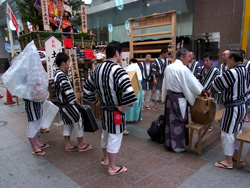
The Priest Arrives I think those guys had to carry his stuff for him.
|

Offerings to the Gods
|
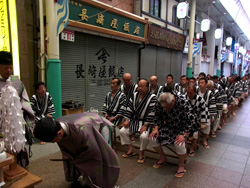
Let the ritual begin!
|
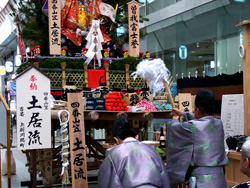
The Priests do their thing
|
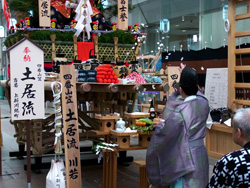
And the throwing of paper is involved. If you haven’t noticed, paper seems to play a big part in the Shinto religious traditions. This is one way of blessing places.
|
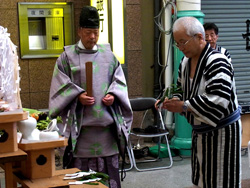
Some of the important people get blessed. I have a feeling that this guy was the dollmaker… I’m not 100% sure though.
|
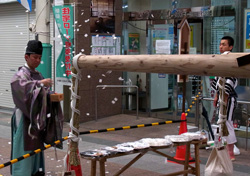
Blessing the periphery |
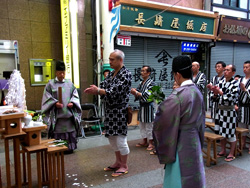
More blessings
|

Some instructions for the boss ..is what this looks like.
|
All bow… and we’re done.
|
Blessing the Peripherals
On the day leaf and paper decorations miraculously appeared around town, a troupe of Kakiyama carriers gathered at the “huts” set up especially for the purpose. Again a Kushida priest came along, and again he performed a blessing and offered some offerings, finishing by reminding the participants of their responsibilities and blessing them with a safe festival season.
This time the subject is not the Kakiyama, but a pile of freshly cut bamboo sprigs and trees and bags full of loops of straw and paper. All of this was then promptly hung up around town, to follow the route that the Kakiyama will take on its many journeys through practise and the real Oiyama too.
These sprigs not only mark the road but bless it too, as the path of the Kushida Gods through the town.
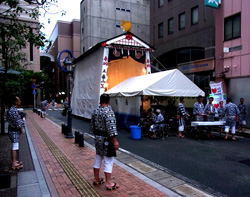
Chilling outside the tent.
|
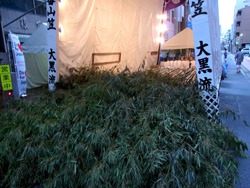
Some peripherals! These will go up alongside many of the lampposts and other tall, cylindrical things around the areas where the Kakiyama will pass. Not just the main course but the practise runs as well.
|

The setup before starting I thought the priest wasn’t here yet, but he’s actually on the right. I think they’re waiting for the right time…
|
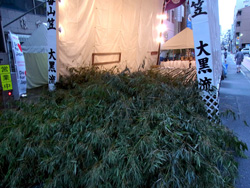
Bow towards Kushida
|

The Ceremony Begins… The Priest does his mysterious priestly things here. Shinto priests have a wand tipped with paper streams that they use as part of their ritualness.
|
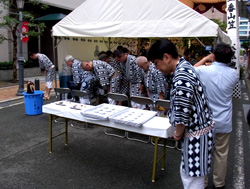
Serious even outside the seating area. As always, the most important people get the most important spots. So the lackeys have to stand outside.
|
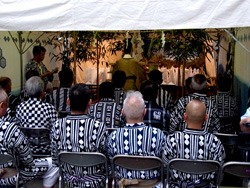
Blessing the participants |

Bowing to the Altar
|
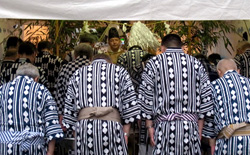
Blessing the Ground Using paper confetti. It’s pretty cool looking…
|
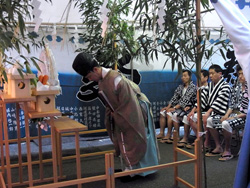
The wand in action Yep!
|
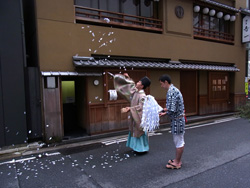
More paper flakes His assistant looks very serious.
|
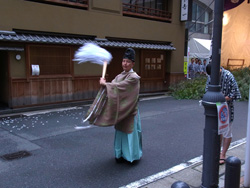
Sacred Sake, to be consumed by the participants. They’re very small cups.
|
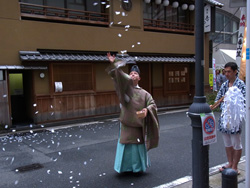
The Altar. I always wonder where food left like this goes after the ceremony is done. 90% certain it ended up in the participant cafeteria…
|

Bamboo Shoots marked by place They’re pretty precise about this, right?
|
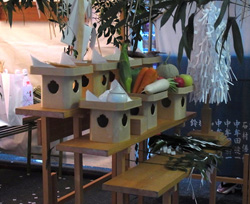
Goodie bags! These, also blessed, are going up on lamp posts. They’re the straw-paper-leaf arrangement I’ve mentioned before.
|
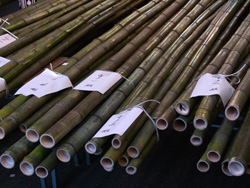
Carrying the shoots to location
|
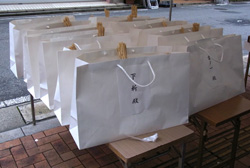
Getting some knots happening…
|

Up with the power of three!
|
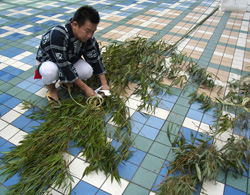
And a bit of assistance to get it tied right. Yep. I’ve never seen the street with that little traffic, coincidentally.
|

Tying on with cable ties?
|
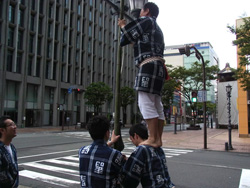
Leaves for the world to see! These are really tall bamboo shoots. Should I be saying trees? Some of them have gone brown by now, after a week of display. I wonder if that’s all part of the festivities too….
|
Sand at the Hakozaki Seaside
An army of men and boys 6,000 strong gathered on an ancient bridge, under the shade of a two-tier tollway, to make an ancient run through 4km of suburban streets to the seaside at Hakozaki. The course, 3 subway stations long, is run by just the core members of the festival (the “important” participants; those that have been there from birth or for decades and decades) on the 1st of July (when running is interrupted by traffic) and every member of the Kakiyama Carrier Corps across all Streams on the 9th of July. On the way back after passing the bridge into Old Hakata, the teams go their separate ways to reach Kushida, then their separate ways again to get back to home turf.
They pray at the Hachiman shrine for success, victory, and (most importantly) lack of injuries during the festival’s Oiyama run.

Ready to Run! Groups of men, a total of about 60-100ish, come and do their greeting to the big Nagare chiefs group by group.
|
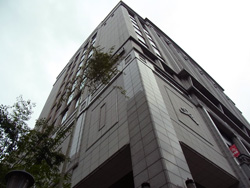
Polite Greeting to the Big Chiefs The world of Yamakasa is apparently very regimented, with levels and manners more precise than your average Austen novel.
|
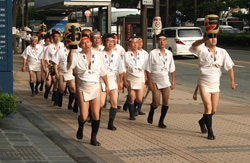
Hakozaki! A straight stretch of road. This is the view you get when getting off at the Hakozaki Shrine subway stop. It’s a dead straight road from the shrine (behind me) to the beach up ahead, making this a holy passage.
|

Massive Torii These are neat, aren’t they? The men will hit the road on the preceeding image, then group by group assemble, cross a fairly busy intersection and go to the little patch of beach designated as Hachiman Gu’s holy patch.
|
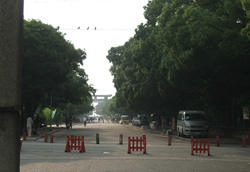
The second Torii! And media is gathered… As it’s the first day of the festival (1st July) there’s a bit of a media presence. The biggest station represented Nishi Nihon, so I guess this went as far as Kansai…?
|

Waiting around for the next team to arrive. There wasn’t much to do between each Nagare’s arrival except wade in the water, look for good angles and get bit by mosquitoes. An old man started talking to me about Yamakasa, so that helped pass the time.
|
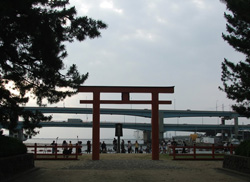
And we’re all fired up! As each team grew closer, the cameras would get all serious suddenly. I wasn’t the only one on the other side, but now that I think about it they were bunched together for a reason… so that their broadcast wont’ have too many cameras in it. As it was, I had STACKS in my photos. Ah well!
|
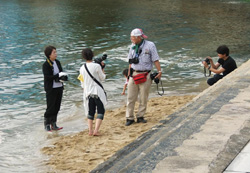
Bow and clap their hands, that’s the greeting. People would drift away after they’d finished that.
|
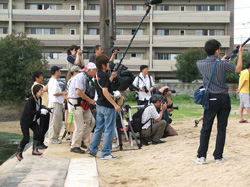
This guy was so cute! |
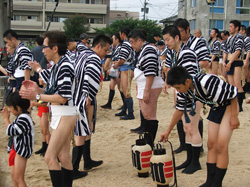
Fetching Sand After the prayers were over, some of the team climed down to fetch sand from that tiiiny little sandbar in the water.
|
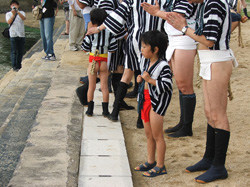
The sea! Still waiting. Some of the boats in Fukuoka Harbor were huge…
|
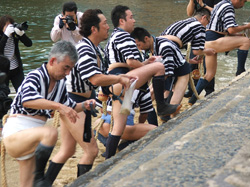
Another team arrives! It’s interesting that every team wears their combination of uniform slightly differently at this event.
|

Lanterns! |
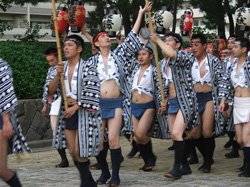
Them & the Media Sorry guys… I’ve probably ruined your shot…
|
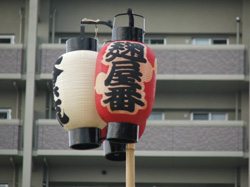
Fetching Sand This is Higashi now! My guys have arrived. |

Fetching sand #2
|
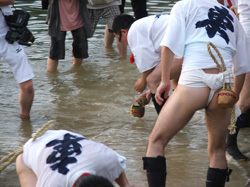
And going back… I must say I’ve become quite immune to the whole man butt thing. You see so much of it over the festival season…. you really don’t even notice anymore.
|
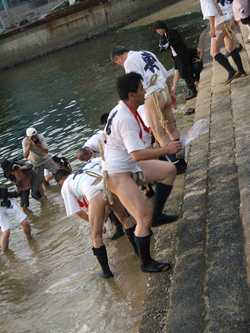
Tying sand on to carry back That box had sand in it too.
|
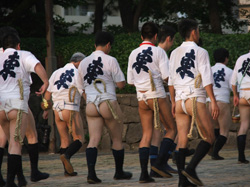
More sand! I might have already mentioned this but, some people took extra as it’s said to protect families from accidents & trouble, and not just Yamakasa participants.
|

Sunset nearing at the Hakozaki beach! There were some massive highways that blocked the view a little bit.
|
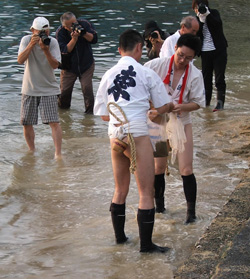
Crossing at the lights. |
|
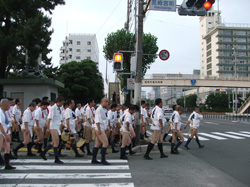
And doing the rounds. I’m glad they didn’t really mind cameras taking photos…
|

And then taking a break before running back. Wonder where all those underlings went? Actually it’s their job to bring food & drinks for their seniors to enjoy after they’ve done their run to Hakozaki. That’s right… they get catering! Lucky guys! Won’t happen on the 9th though.
|

Kushida Shrine at Night!
|
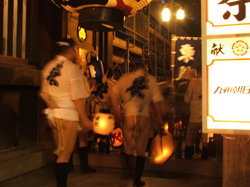
Here they come! It’s not hard to beat a bunch of running guys when you have the subway system on your side. Each team runs back to Kushida and gets blessings here too.
|

Lining up for holy sake, foods A lot of people come to Kushida on the days that these guys are running… not to see them, but to get some “free blessings” because the priests are out in full force with their blessing wands. So you’ll get a bit of extra goodness in you from visiting compared to a normal day.
|
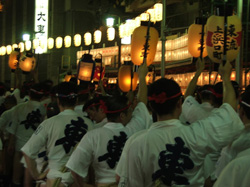
Run of the Lanterns! Aren’t these great? I don’t even care that they have advertising on them. With their voices ringing in the night, the men of Higashi Nagare will run back through the streets to their home base, to get free dinner and drinks. It’s a pretty neat atmosphere, everyone running and cheering like that.
|
———
And they’re the main rituals!
Of course, most of the “serious” practise runs will have a loop around Kushida shrine… and the “victory song” will be sung at the Shrine by the team that gets to go first. But that’s a story for another day.
Yamakasa-Navi Correspondence
Viewing Guide
Trivia
Even More Information


